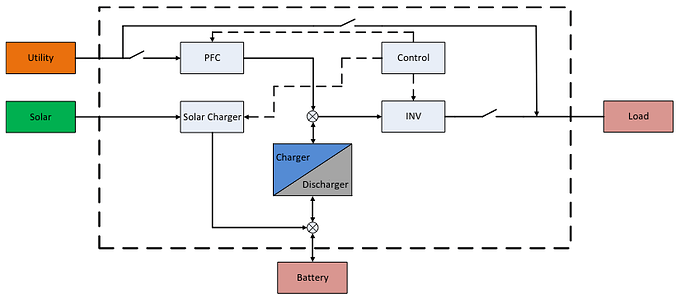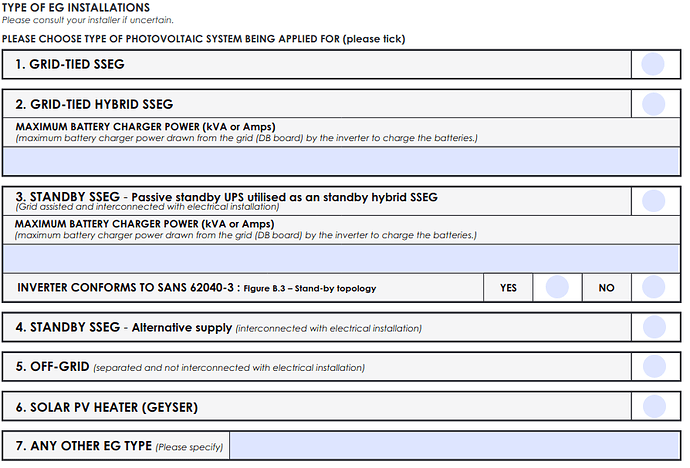I have read that this inverter has a ‘one way grid-tie’ capability?
See: https://www.4x4community.co.za/forum/showthread.php/359877-Solar-installation-City-of-Cape-town?p=4954138&highlight=#post4954138
See post #16
I don’t think there is any meaning to that term? Grid-tied by definition means you can export, which none of them can. It’s only in our country where exporting is bad (because we don’t need your excess energy, we have plenty of power /s).
The axperts seemingly are able blend now for a while, how well they do it I don’t know, which models can is also a bit of a mystery. The axpert king mentioned in the post (AFAIK), is a double conversion device - meaning it takes incoming AC, makes it DC (with power factor correction included) and adds it to the HV bus before it blends it with the other sources, and it certainly cannot export (I might be wrong here, it’s based on assumptions).
Overall these devices are definitely designed for obsolescence - they used to have tons of protection built in - arrays of TVSs everywhere. Now it seems that they have removed that, which I assume, boosted sales a lot. I guess they work (for a while) and they’re cheap, but there are offerings that are built to a MUCH better standard that cost less than the price of your first 2 Axperts…
Diagram of Axpert King topology:
There needs to be a name for these to differentiate them…
The ‘blending’ means that the mains frequency isn’t synchronised to your frequency. (got to be some losses there… ![]() )
)
And all loads are supplied by the (running) inverter whether grid power is on or not.
Why would it mean that? There are many inverters that blend while maintaining lock with the grid.
The grid and the inverter output are not connected (as is the case with all double conversion inverters/UPSs)
I assume there’s no need to synchronise the two… ![]()
Yes, there might not be a need, but as you can see from the diagram, there is also a bypass, presumably for when the load exceeds capacity, or battery disconnect etc. In that case you would want to have a synchronized switchover. And adding that capability is not very difficult, in fact it is a bit easier maintaining lock in the double conversion case.
If you want to be bi-directional, then you need to lock with the grid.
I believe the Axpert King simply rectifies the incoming AC with something akin to a “normal” rectifier, and that goes to the HVDC bus which is then turned back into AC by the final stage. That means you don’t really need to run at the same frequency at all, or “locked”.
As you say though, maintaining sync with the frequency (without having a full lock, so to speak) is a lot easier, if you want to add a bypass that doesn’t cause a vector shift every time it closes.
Another thing I wonder about: To what extent this topology affects power factor. Power factor is somewhat affected by DC rectification. Maybe they thought of it.
Reason I said something about “full lock”, which sounds a bit weird probably, is that you can sinusoidally lock with a signal that is not quite sinusiodal, and that causes energy to move back and forth between the two sides. I should write a separate post about that.
Yes, they have PFC (if you look at the diagram).
Traditionally the Axpert inverter (and all the identical branded offerings) are considered to be off-grid inverters. Since this King model can draw power from the grid and PV this has produced a subtle upgrade to the status of this inverter.
Particularly in SA with the complication of grid-tie inverters having to be hobbled and prevented from feeding back to the grid. My experience is in order achieve this all sorts of expensive extra equipment needs to added to one’s system.
Grid-tie inverters are sophisticated so they are also expensive. It defeats the purpose of a grid-tie inverter if you prevent it feeding back to the grid, something it was specifically designed to do.
This Axpert King has the advantage of being a lot cheaper and doing the exact same job that 99% of the grid-tie inverters are doing.
Here we go again. ![]()
In short:
… complication of grid-tie inverters … hobbled and prevented from feeding back … defeats the purpose of a grid-tie inverter … Grid-tie inverters are sophisticated
My experience … all sorts of expensive extra equipment … added to one’s system.
… expensive … Axpert King … lot cheaper and doing the exact same job
My views:
I think here, and on the other forums, grid-tied inverters have been explained in great detail. Not much more to be said.
We have experience here, and on other forums, of actually owning and using grid-tied inverters, not just on what others say.
We also have experience here, and on other forums, of what the regulations say and mean, to help us help ourselves, even if we don’t agree with all the regulations, the regulations dictating the NRS certification required, as also explained on various forums.
Many of us here have actually experienced the value of “you get what you pay for” when the chips are down, repairs are needed, advice is sought or warranty replacements are needed on a device we bought 5th hand … with free ongoing manufacturers support.
Just saying.
Grid-tied inverters are not complicated nor complex, the regulations require these enhancements to them. Thank heavens we now have those cool features.
We don’t want to feed back to the grid for various reasons. Good reasons for that too, I may add, none of these reasons are linked to specific inverter brands either.
Car analogy … not all cars are equal, not in performance, support, service, or in price.
Experience is something one has actually done oneself, 'walking the talk, not talking the walk".
It certainly does not. It cannot “blend” beyond it’s capability, like the true hybrids can (though some only on the non-essential side).
BTW, their use of “off-grid” is also a bastardization of the term. It seems like the lower tier brands are actively trying to cause confusion of terminology to make their offerings less distinct (on paper) from better inverters.
For the record I used the term after enquiring what this system is called and didn’t receive an answer…(and couldn’t think of a better one ![]() )
)
Recently I’ve noticed a couple of people I know have had these systems installed. When I asked how the changeover was done between grid power and inverter and not getting an answer I started piecing it together with the help of @_a_a_a
Typically these systems are for surviving load shedding and don’t have any solar PV. (but the owners are quick to point out that PV can be added…)
I know. I think it should be something like offline (like a UPS)? It’s basically a UPS with an MPPT strapped on top.
As always, it’s a pros and cons thing. The double-conversion architecture has advantages. No transfer break for example (none of that 20ms nonsense). Another advantage is better output voltage regulation, since you’re basically always on the inverter.
The downsides are an efficiency loss, and with some models (I don’t think they all had the bypass?) you’re also limited to the max the inverter can pass through it’s HV bus. You also cannot push energy from the batteries into the input side, which is something some people want (of course not everyone).
On a really good grid connection, the grid signal will always be cleaner than anything an inverter can make, which again means that with this inverter (where you are permanently on the inverter), you have a little more harmonics in your power than you would if just switched directly from the grid. If the grid is really poor, this is an advantage, otherwise it can be a disadvantage.
Mostly, the trouble with the Voltronic inverters is that they don’t have paperwork. They often live in this no-man’s land where nobody is sure what they are. Under Cape Town rules they are a “standby SSEG”, option 3, as seen below, even though many installers sign them off as option 4 or 5 (which they are not).
That means they need to comply with SANS 62040-3. And maybe they do, but they don’t have the paperwork. @Stanley mentioned here that in order to comply with -3 you also need -1 and -2, which means both safety and EMC requirements.
I have a 1kVA Delta UPS and the specs state: Pure Sine Wave
Axpert, Axpert King, Synsynk, Victron, SMA, GoodWE … all are Pure Sine Wave.
That’s a marketing term for “not square wave” ![]()
If you zoom into the sine wave of just about every inverter, including our favourites, you will see it has a slight step in it. That’s also why the THD (total harmonic distortion) is never completely zero.
Some video content here. And some inverter generators here.
His mains doesn’t look too good ![]()

